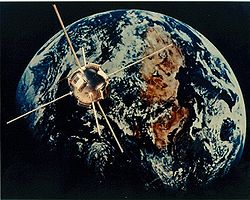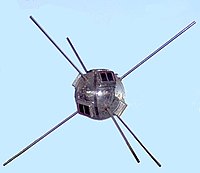Vanguard 1
| Vanguard 1 | |||||||||||||
|---|---|---|---|---|---|---|---|---|---|---|---|---|---|
| Phase : E2 / Status : in orbit, out of order | |||||||||||||
 Artist's impression of Vanguard 1 in orbit |
|||||||||||||
| Type: | Research satellite | ||||||||||||
| Country: |
|
||||||||||||
| Organization: |
|
||||||||||||
| COSPAR designation : | 1958-002B | ||||||||||||
| NORAD / SCN-ID : | 5 | ||||||||||||
| Mission dates | |||||||||||||
| Start date: | March 17, 1958, 12:15 UTC | ||||||||||||
| Starting place: | Cape Canaveral , LC-18A | ||||||||||||
| Launcher: | Vanguard TV-4 | ||||||||||||
| Mission duration: | 2,200 days | ||||||||||||
| End date: | May 1964 (estimated re-entry: approx. 2198) |
||||||||||||
| Orbit data | |||||||||||||
| Origin of coordinates: | earth | ||||||||||||
| Rotation time : | 132.7 min | ||||||||||||
| Apogee : | 3,840 km | ||||||||||||
| Perigee : | 657 km | ||||||||||||
| Eccentricity : | 0.1844061 | ||||||||||||
| Orbit inclination : | 34.25 ° | ||||||||||||
| General spacecraft data | |||||||||||||
| Takeoff mass: | 1.47 kg | ||||||||||||
| Dimensions: | Diameter: 15.2 cm | ||||||||||||
| Manufacturer: | Naval Research Laboratory | ||||||||||||
| Others | |||||||||||||
| Previous mission: |
Explorer 2 | ||||||||||||
| Subsequent mission: |
Explorer 3 | ||||||||||||
|
|||||||||||||
Vanguard 1 (also called Vanguard TV4 or Vanguard 6.5in-Sat 3 ) is an American research satellite from the early years of space travel. It is the fourth artificial satellite and the first spacecraft to use solar cells for power supply. The satellite was launched in the Vanguard project and was operated by NASA .
technology
Vanguard 1 was built by the Naval Research Laboratory (NRL) and is tiny compared to Sputnik 1 . It is identical to the two previous Vanguards. It weighs only 1.5 kg and is the size of a grapefruit. The power supply ran through batteries and solar cells. The satellite has six antennas, each of which protrudes to the side.
history
After the failed launch attempts by Vanguard TV3 and Vanguard TV3BU , the Naval Research Laboratory ventured another launch. This also succeeded. Vanguard 1 was launched on 17 March 1958 with the three-stage Vanguard - carrier rocket with the serial number TV4 (Test Vehicle 4) from the spaceport Cape Canaveral in Florida in a medium earth orbit (MEO). It was the first successful launch of a Vanguard rocket, and the satellite is the oldest human-made object in space.
Vanguard 1 was placed on an elliptical orbit with a lowest point of 650 km and a highest of 4,000 km, which was inclined at about 35 ° to the equator . Originally, with a stable orbit, a lifespan of around 2000 years was assumed. However, it turned out that the solar radiation pressure and the atmospheric resistance caused significant disturbances in the perigee height of the satellite during high solar activity , which leads to a significantly reduced service life. It is estimated that the lifespan of Vanguard 1 will only be around 240 years and that the satellite will enter the Earth's atmosphere around the year 2200. The battery-operated transmitter was exhausted and stopped transmitting in June 1958. The solar powered transmitter, however, worked until May 1964 when the last signals were received in Quito , Ecuador .
Web links
- Vanguard (6.5in) on Gunter's Space Page (English)
- Vanguard 1 in the NSSDCA Master Catalog (English)
Individual evidence
- ↑ Railway data according to VANGUARD 1. N2YO, April 7, 2018, accessed on April 7, 2018 (English).




